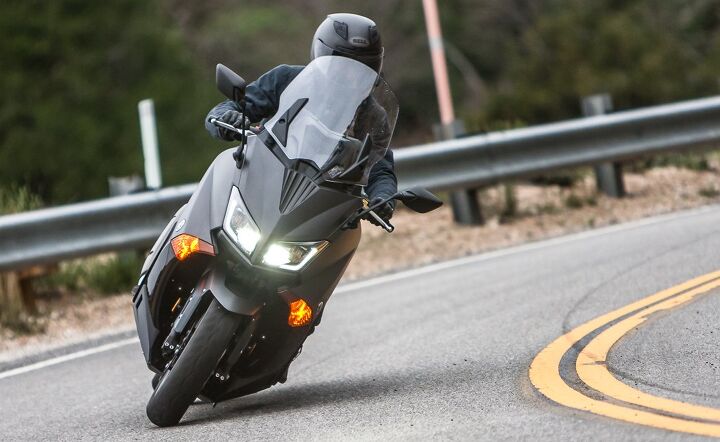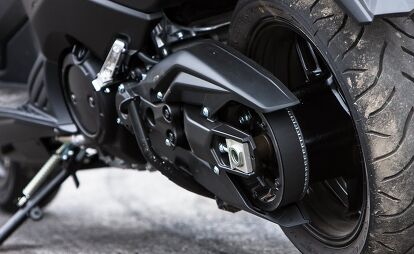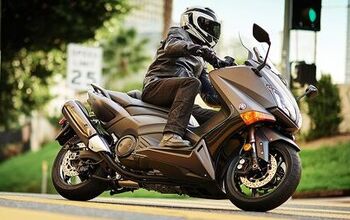2015 Yamaha TMAX Review

Putting the Sport into Scooter
Once there was a time when scooters were looked down upon in the motorcycling world. Perhaps it was because they were anemic, under-powered, funny-looking things. Well, those days are long gone. The class of scooters has grown beyond the baubles that only a college coed would want to be seen on to include a wide range of price and performance from modest, econo-scoots to what we called Uber Scooters in our 2013 shootout. When readers pointed out that Yamaha had been left out of the mix, our response was that as soon as the tuning fork company decided the United States market was deserving of the TMAX, we’d be happy to include it. Well, Yamaha must have been listening to us, because for 2015 the TMAX is available stateside.
Yamaha PR has labeled the TMAX “the Sportbike of Scooters,” and others have credited the TMAX with being one of the inspirations for the maxi-scooter trend. So, we were more than a little excited to add one to our stable of bikes for some commuting, errand running, and back road thrashing. First, however, you’ll have to read about why we thought the TMAX would be a fun ride.
A frequent shortcoming of scooters is the flexibility of the frame due to the step-through design providing a great place for torsional flex. While the TMAX isn’t a true step-through – rather, more of a step-over – the chassis still has to battle the narrow section between the front wheel and the rear. Yamaha’s remedy was to give the TMAX a Control Filled die cast aluminum frame with the engine bolted on as a stressed member – kinda like they do with sportbikes, no? Bolted to the front of that sexy aluminum is a 41mm inverted fork while an aluminum swingarm maintains rigidity without a weight penalty in the rear. Keeping all that aluminum from touching the ground are a set of 15 in. cast wheels shod with a 120/70–15 front and 160/60–15 rear Dunlop Sportmax GPR–100 tires.
Among the other sporty touches included in the TMAX, the front and rear suspension travel 4.7 in. and 4.6 in., respectively, giving plenty of stroke to handle bumps encountered in urban commuter duty. Additionally, the dual 267mm front discs are clamped by radial mount, four-piston calipers. The rear disc is an even larger 282mm, though embraced by a single piston caliper. With this much braking power available to the rider, we have to wonder why Yamaha chose to forego ABS even as an option (which it is in Europe).
A forward inclined 530cc parallel-Twin powers the TMAX. The DOHC heads breathe through four valves per cylinder with an emphasis on low- to mid-range power while the constantly variable transmission (CVT) makes sure the engine’s rpm are kept in the appropriate range for the task at hand. When accelerating on a highway entrance ramp, the ECU keeps the mill spinning in the range of optimum power, making the TMAX merge into the traffic flow with little stress, unlike some scooters with smaller engines or less optimized power delivery. At a cruising speed of around 80 mph, the engine spinning at 5,500 rpm, the TMAX is amazingly smooth with enough roll-on power on tap to not feel overtaxed. Once the speedometer reads closer to triple digits, some vibration reaches the rider, but again, the engine doesn’t feel labored. In fact, the only time the TMAX’s engine felt overworked was when it was being ridden above 5,000 ft. Then it was apparent the engine was only a half-liter.
Around town, the TMAX’s throttle response was remarkably crisp. With most scooters, there is a bit of hesitation when pulling away from a stop, as the CVT spools up before transferring power to the rear wheel. In the case of the TMAX, forward motion is generated the instant the throttle is twisted – a characteristic that surprised one tester when he was taking a left turn across traffic from a side street. Because there was no delay in the bike’s launch, the TMAX leapt forward a fraction of a second sooner than he expected almost causing him to clip a rear bumper as it passed in front of him. This will not be a problem for TMAX owners, only motojournalists who currently have three scooters parked in their driveway.
Another area that was surprising – and not in a good way – is the TMAX’s beaminess. The already-tall-for-a-scooter seat height of 31.5 in. is made even more so by the shape of the bodywork under the seat. A tester with a 32 in. inseam found his thighs resting against the bodywork (much in the way one’s legs wrap around a horse when in the saddle) even when he was standing on the balls of his feet. The TMAX’s cornering clearance requires the tall seat height, but the width of the scooter is odd, particularly since the under seat storage is pretty cramped, largely taken up by the 4.0 gallon tank. It will hold a full-faced XL helmet, but it still required some fiddling to get the seat to close. Yamaha thoughtfully includes a helmet cable for securing your (or your passenger’s) lid to the seat locking mechanism.
+ Highs
- Great ground clearance
- Strong brakes
- Willing engine
– Sighs
- High, wide seat
- No ABS option
- Small storage space
Once seated in the cockpit, the accommodations are roomy and comfortable. Long-legged riders will appreciate being able to place feet forward against the angled footrests. The grips are strangely low, not uncomfortably so, but odd, nonetheless. Apt Analogy Editor, Tom Roderick, likened the arm position to that of pushing a wheelbarrow. Still, the steering is neutral and responsive. As is often the case with scooters, the feedback from the front tire is minimal, but the TMAX is capable of maintaining some amazing lean angles with nary a twitch nor a shimmy. In a day of riding in the mountains, only the center stand feeler (Yes, on the right side, there is a center stand feeler.) touched down after hitting a bump in a sweeper.
As you’re scrubbing off the speed while approaching a tight corner, a rider’s thoughts may again turn to the question of why ABS is not offered on a scooter with such powerful brakes, particularly when one considers that scooter buyers are often less experienced riders.
While we’re wondering about overlooked features, we have to wonder why a scooter priced in the premium range of $10,490 wouldn’t have an easily adjustable windshield. This becomes all the more apparent to riders in the 5 ft. 11 in. range when on the highway. The TMAX offers great weather protection, but the turbulence off the top of the windscreen, when set in the low position, creates an annoying level of of helmet noise. Although the turbulence doesn’t jostle the rider’s head, it does create quite a racket inside the helmet. Relocating the windshield in the tallest position was enough to silence the beast, thankfully – though it did require a trip to the tool kit.
One premium feature which has many benefits is the wireless ignition. As long as you have the fob in your possession, the bike can be started, the under seat storage can be opened, and even the handlebar can be locked/unlocked. If the key fob battery ever fails, a traditional ignition switch is located inside the locking dash storage compartment. This will also enable the trunk to be opened.
Riders who want to have sportbike-like performance from a scooter should actively look at the 2015 Yamaha TMAX. Had it been available here in 2013, it would have done very well in the Uber Scooter Shootout. So, if any of those scoots tickled your fancy, you should add the TMAX to the list of scooters worth investigating. Perhaps we’ll even gather the maxi-scooter tribe together for a reunion smackdown with the new kid.
| 2015 Yamaha TMAX Specs | |
|---|---|
| MSRP | $10,490 |
| Engine Type | Liquid-cooled, 4-stroke, forward inclined parallel 2-cylinder, DOHC, 4 valves per cylinder |
| Engine Capacity | 530cc |
| Fuel System | Electronic fuel injection |
| Transmission | CVT |
| Final Drive | Belt |
| Frame | CF die-cast aluminum frame |
| Front Suspension | 41mm upside-down telescopic forks with – 4.7 in of travel |
| Rear Suspension | Mid ship horizontal positioned rear shock – 4.6 in of travel |
| Front Brakes | 267mm dual hydraulic discs; four-piston, radial mount calipers |
| Rear Brakes | 282mm hydraulic disc; single-piston caliper |
| Front Tire | 120/70-15 |
| Rear Tire | 160/60-15 |
| Seat Height | 31.5 inches |
| Wheelbase | 62.2 inches |
| Rake | 25° |
| Trail | 3.6 inches |
| Wet Weight | 485 lbs |
| Fuel Capacity | 4.0 gal |
| Fuel Mileage (as tested) | 45.2 mpg |
| Range | 180 mi. |

Like most of the best happenings in his life, Evans stumbled into his motojournalism career. While on his way to a planned life in academia, he applied for a job at a motorcycle magazine, thinking he’d get the opportunity to write some freelance articles. Instead, he was offered a full-time job in which he discovered he could actually get paid to ride other people’s motorcycles – and he’s never looked back. Over the 25 years he’s been in the motorcycle industry, Evans has written two books, 101 Sportbike Performance Projects and How to Modify Your Metric Cruiser, and has ridden just about every production motorcycle manufactured. Evans has a deep love of motorcycles and believes they are a force for good in the world.
More by Evans Brasfield





















































































Comments
Join the conversation
Has anybody ridden the 500 and 530 Tmax? How much better does it run?
https://uploads.disquscdn.c...
I Love Tmax ;) ♥♥